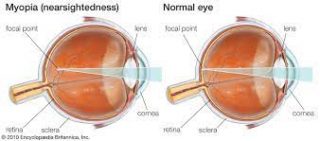
During forced home confinement, we should deliberately keep child eye health in perspective. With a shifting trend towards online school and study this becomes more imperative. Myopia also termed nearsightedness or shortsightedness is a refractive error typified by one’s inability to clearly see objects at a distance. Symptoms of myopia in children include:
- Sitting too close to the television
- Holding books, homework or screen devices like tablet close to the face
- Squinting or closing one eye to read
- Frequent headaches
- Excess watering of the eye
- Rubbing eyes
Refractive errors such as myopia, if uncorrected, can affect school performance, limit occupational choices for the child, and impair quality of life. Myopia, especially progressive myopia increases the risk of developing potentially blinding eye conditions like glaucoma, cataract, retinal detachment, maculopathy, retinal bleeding etc.
Age of onset is an important predictor of high myopia in later childhood. Thus, children with early onset myopia are at higher risk with longer duration of the disease, higher chances of disease progression and consequent ocular complications. Prevention, early detection and timely intervention is therefore vital in children.
Risk factors for developing myopia include:
- Genetic predisposition: family history of myopia.
- Lack of outdoor activity: spending little time outside. Studies showed that sustained hyperopic defocus (i.e. lack of viewing objects at distances) which is generated indoors, predisposes to myopia.
- Prolonged near work: Holding books too close to eyes; prolonged periods of exposure to screen time, hand-held devices and television may eventually lead to reduced ability to see things at a distance.
- Constricted living space may be an environmental threat for myopia development in children (we cannot help this in some areas in Lagos).
- Low blood vitamin D concentrations has been implicated in myopia. However, the use of vitamin D supplements has not been confirmed as being helpful.
- Some congenital and systemic diseases are also implicated in myopia.
How can we curb/control early onset of myopia?
- Increase outdoor activities: This has been proven to be the strongest environmental factor that can delay myopia onset. Randomized Control Trials showed that increased outdoor activities inhibits myopia progression in children aged 6 to 7 years by as much as 30% in 1 year. Exposure to outdoor sunlight, increases dopamine receptors in us and provides vitamin D. This also activates genes that help release the right amount of dopamine required to regulate adequate eye development. Before 10am and after 4pm is a good time to enjoy time outdoors. Vieing distances are much greater outdoors, during this period, caregivers can find creative, safe ways to increase outdoor time for the children e.g. take them outside for multiple short breaks or for supervised walks in your immediate environment. You can deliberately create games like ‘spot the bird on that tree’ or ‘I can see that star’ which encourages the child to focus on distant objects. In between online classes children should be allowed short breaks outdoors to combat hyperopic defocus.
- Reduce screen times: Whilst there are many resources being promoted for online learning, consciously ensure that the child is given time off these online tools.
- do not overload them with online schoolwork, take short breaks in between subjects;
- find creative ways around the home to teach them outside of these online resources.
Note that the effect of near distance activities on onset of myopia and its progression is typically higher in younger children, therefore stricter control on the use of these devices/screens among pre-school children is wise.
The Canadian pediatric association reported recently that, ‘early learning is easier, more enriching and developmentally more efficient when experienced live, interactively, in real time and space, and with real people’. [More information on this can be found on https://www.cps.ca/documents/position/screen-time-and-young-children]
- Reduce game/movie time: Engage children in more enriching games like scrabbles, monopoly, chess which teach these children very valuable life skills, while promoting family bonding. Human contact like hugging your child can increase their dopamine levels which is good for the eyes, so more bear hugs please!!!
- Healthy diet: Other conditions that have been associated with increased myopia include high body weight, and westernized dietary habits. Therefore, healthy diet is very beneficial for eye health in children in addition to boosting their immunity against virus infections. Fish, leafy green vegetables, eggs, carrots, berries, citrus fruits, nuts, beef, red oil etc. Less of processed foods, snacks/ drinks and more of freshly squeezed fruits etc. is beneficial for children.
If you notice any symptoms, please contact your eye specialist.
References
- Holden BA, Fricke TR, Wilson DA, et al. Global prevalence of myopia and high myopia and temporal trends from 2000 through 2050. Ophthalmology. 2016;123:1036–42.
- Grzybowski, A., Kanclerz, P., Tsubota, K. et al.A review on the epidemiology of myopia in school children worldwide. BMC Ophthalmol20, 27 (2020). https://doi.org/10.1186/s12886-019-1220-0.
